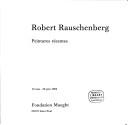Check nearby libraries
Buy this book

In the early 1970s, Rauschenberg moved his permanent studio from New York City to Captiva Island, off the Gulf coast of Florida (Today, this site is in use as the artists' residency program of the Robert Rauschenberg Foundation). This relocation marked a shift from the gritty urban detritus that had been the basis of much of the earlier work to a rhapsodic embrace of color and geometric abstraction in a wholly new vernacular language. The Jammers series (1975-76), its title a direct reference to the Windjammer sailing vessel, is Rauschenberg?s salute to his new island life. In 1975, he also went to India to investigate textiles and papermaking, and the inspiration of this new and exotic context is evident in the use of vivid colors and nuanced textures of cotton, muslin, and silk. For the most part, the Jammers comprise stitched fabrics in pure, solid colors, affixed to rattan poles or hung directly and loosely on the wall; whereas in works such as Sprout (1975) and Caliper (1976), the unadorned poles are the principal formal element, propped against the wall. Departing from Rauschenberg's densely collaged imagery or muscular, layered materials, the Jammers are simple and light, focusing on the transparency and seductiveness of veil-like fabrics, that are lent sculptural structure by the cloth-covered poles or other found objects. In Quarterhorse (1975), segments of blue, green, tan and yellow cloth evoke sandy beaches, palm trees, and bright sunshine. In Index (1976), widths of gleaming azure and white satin drape together, a diptych of clouds and sea. The hot, saturated hues of Pimiento III (1976) and Mirage (1976) attest to more exotic influences; while Coin (1976) incorporates found tin cans, stripped of their labels, gleaming mysteriously inside a gauze bag that sags under their weight.--Gagosian website.
Check nearby libraries
Buy this book

Previews available in: English
Subjects
Assemblage (Art), Exhibitions, Art and technology, Criticism and interpretation, American Painting, United States, Illustrations, Expositions, Installations (Art), Found objects (Art), Individual artists, Art & Art Instruction, Art, Rauschenberg, Robert, Individual Artist, Art / Individual Artist, Rauschenberg, robert, 1925-2008, Malerei, Objektkunst, Assemblage (art), Art, modern, 20th century, exhibitions, Rauschenberg, robert , 1925-, Assemblage (art)--united states--exhibitions, N6537.r27 a4 2005, 709.2Places
United StatesTimes
20th centuryShowing 4 featured editions. View all 33 editions?
| Edition | Availability |
|---|---|
| 1 |
cccc
Libraries near you:
WorldCat
|
| 2 |
cccc
Libraries near you:
WorldCat
|
|
3
Robert Rauschenberg: cardboards and related pieces
2007, Yale University Press
in English
0300123787 9780300123784
|
cccc
Libraries near you:
WorldCat
|
|
4
Robert Rauschenberg: peintures récentes, 12 mai-30 juin 1984 : [exposition].
1984, Fondation Maeght
in French
2900923034 9782900923030
|
aaaa
Libraries near you:
WorldCat
|
Book Details
Edition Notes
Classifications
The Physical Object
ID Numbers
Community Reviews (0)
Feedback?History
- Created April 1, 2008
- 7 revisions
Wikipedia citation
×CloseCopy and paste this code into your Wikipedia page. Need help?
| November 2, 2020 | Edited by MARC Bot | import existing book |
| July 31, 2010 | Edited by IdentifierBot | added LibraryThing ID |
| April 16, 2010 | Edited by bgimpertBot | Added goodreads ID. |
| April 13, 2010 | Edited by Open Library Bot | Linked existing covers to the edition. |
| April 1, 2008 | Created by an anonymous user | Imported from Scriblio MARC record. |












